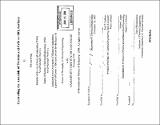Controlling the assembly of proteins and cells on SiO₂ surfaces
Author(s)
Seong, Jiehyun, 1973-
DownloadFull printable version (11.47Mb)
Other Contributors
Massachusetts Institute of Technology. Dept. of Chemical Engineering.
Advisor
Paul E. Laibinis and Robert Langer.
Terms of use
Metadata
Show full item recordAbstract
A variety of devices -- biochips, implants, and membrane filters among them -- are challenged in their operation by having to contact biological solutions. An ever-present problem for such devices is "biofouling," resulting from the nonspecific adsorption of proteins, cells, and other agents onto their surfaces. The ability to produce surfaces with specifically immobilized biological species that can avoid the nonspecific adsorption of other species has been essential for constructing solid-state devices that interface to biological systems. An effective strategy for achieving "bioinertness" for surfaces is their modification by poly(ethylene glycol)s (PEGs), which provides protein and cell repelling properties. This thesis centers on the development of ultrathin films of PEG on SiO₂ surfaces that 1) can resist the nonspecific adsorption of proteins and cells ("bioinert surfaces ") and 2) can provide surface sites for the specific immobilization of biomolecules ("bioactive surfaces "). Effective methods to achieve these goals were accomplished by incorporating multivalent surface anchoring groups into one polymer chain or by forming densely-packed monolayers of PEG on surfaces. In one approach, bioinert surfaces were prepared by a multivalent attachment of a PEG-grafted polymer backbone to a surface. Two systems were examined: 1) graft copolymers of poly(acrylic acid) expressing PEG-containing side chains, and 2) a random copolymer composed of an "anchor part" (trimethoxysilane) and a "functional part" (PEG). In the first system, PEG-containing films were formed by an electrostatic interaction between the PAA backbone and the underlying amine-modified surface. In the second system, the formation of (cont.) multiple covalent bonds between the anchor moiety and the surface was responsible for generating PEG films. The formation of covalent bonds and the direct coupling of PEG to native surfaces are advantages of this system. The use of these bioinert surfaces for the direct patterning of proteins and cells was also addressed. Capillary force lithography (CFL) technique was applied to form patterned PEG microstructures. PEG microstructures localized proteins and cells onto the exposed surfaces not only by the inert nature of PEG but also by acting as a physical barrier. The number of cells in a given PEG barrier could be manipulated by varying the feature size of patterns. Biofunctional surfaces were prepared from PEG-containing self-assembled monolayers (SAMs). Specifically, an acetate-capped tri(ethylene glycol) (EG₃)-terminated alkyltrichlorosilane formed SAMs (EG₃OAc SAM) that were subsequently reduced to hydroxyl-capped EG₃ (EG₃OH SAM) films produced a non-biofouling surface which simultaneously allows subsequent immobilization of proteins. The attachment of protein A to this surface produced a high density array of this agent for the attachment of antibodies as needed for sensing and other applications. Mixed SAMs of "reactive EG₃" (EG₃0H) and methoxy-capped, "inert EG₃" (EG₃OMe) controlled the surface reactivity and thus the amount of immobilized protein A on the surface. The binding activity of the resulting protein A surface towards immunoglobulin G (IgG) depended on the surface density of protein A and was systematically varied. On the surfaces with high protein A density ...
Description
Thesis (Ph. D.)--Massachusetts Institute of Technology, Dept. of Chemical Engineering, 2004. Includes bibliographical references.
Date issued
2004Department
Massachusetts Institute of Technology. Department of Chemical EngineeringPublisher
Massachusetts Institute of Technology
Keywords
Chemical Engineering.